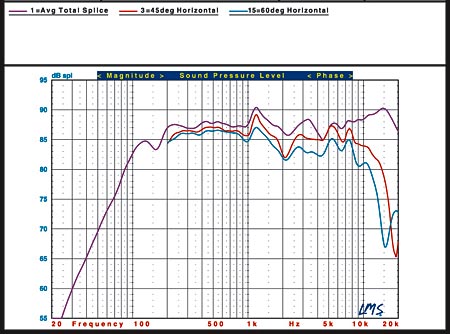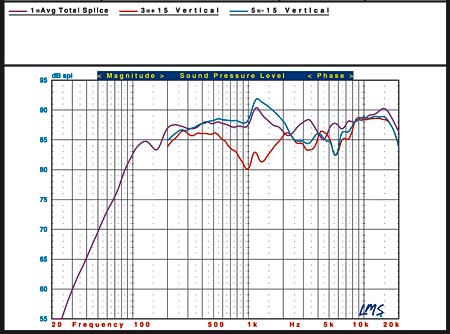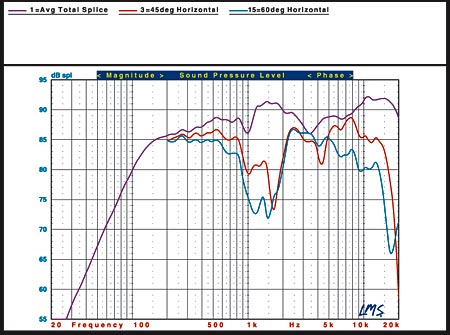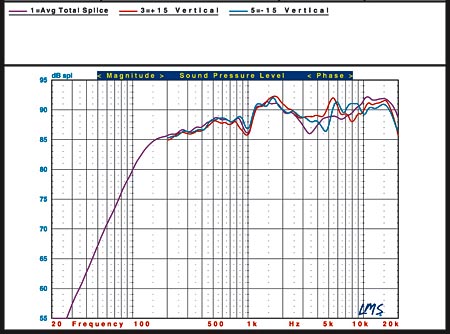EMP HTP-551T Speaker System Measurements
Text by Thomas J. Norton
As mentioned in the main review, EMP has a "sister" company, Destination Audio, and some freestanding products are shared between them. The EF50 series was sent to Steve Guttenberg for review, but a CS500T and CS500C were sent to us for measurement. We are assured that these models are identical to the EF50T and EF50C.
The measurements were taken with the grilles removed, except as noted. The responses with the grilles in place (not shown) were more uneven, with the response peaks between 1kHz and 3.5kHz being more pronounced and the responses above 5kHz being more uneven. The nominal impedances were determined from interpretation of the measured impedance curves (not shown).
All figures: Violet curve: pseudo-anechoic response on the tweeter axis, averaged across a 30° horizontal window, combined with nearfield responses of the woofer(s). All measurements were taken at 1 meter.
Destination Audio CS500T
Minimum impedance: 11.3Ω at 967Hz (see text)
Nominal impedance: 10Ω
Cabinet tuning: 100Hz
Effective bass extension (-10dB): 76Hz (relative to the level at 200Hz)
Sensitivity: 87dB/2.83V/m
The CS500T's measured impedance is higher than average, and its sensitivity is about average, which should make life easy for any respectable amplifier. However, the high impedance—which remains above 10Ω all the way out to 5kHz—means that most amps will put out slightly less than their rated power into this speaker. (The impedance of the CS500T actually dips to 8.5Ω at 10kHz, which is not significant at this high frequency.)

Fig. 1: CS500T, pseudo-anechoic response, off-center in the horizontal plane, at 45° (red) and 60° (blue).
The measured response of the CS500T is relatively uniform, though a bit uneven. The top end rises somewhat, but not enough to suggest an exaggerated treble. The main concern here is the bass response, which exhibits a pronounced downward trend below 200Hz. This might make blending with a subwoofer a challenge, and this system certainly needs a sub for full range home-theater performance. (In his review, Steve Guttenberg does report on the difficulty of mating the sub with this system).

Fig. 2: CS500T, pseudo-anechoic response at 15° above (red) and 15° below (blue) the tweeter axis.
The listening height should be non-critical as long as you remain at or slightly below tweeter height (not above it).
Destination Audio CS500C
Minimum impedance: 7.1Ω at 344Hz
Nominal impedance: 9Ω
Cabinet tuning: 116Hz
Effective bass extension (-10dB): 78Hz (relative to the level at 200Hz)
Sensitivity: 88dB/2.83V/m
As with the CS500T, the impedance results indicate that the CS500C is an easy load to drive. The impedance of the CS500C actually dips to 6.5Ω at 12kHz, but this is not significant.

Fig. 3: CS500C, pseudo-anechoic response, off-center in the horizontal plane, at 45° (red) and 60° (blue).
The speaker's averaged response (violet curve, Fig. 3) is less uniform than that of the CS500T. The broad peak centered at 1.5kHz may produce a slightly forward on-axis sound, but this will be counteracted to some extent by the severe suckout shown at wide off-axis positions. (The suckout is also evident at 30 degrees off-axis, not shown here.) This type of off-axis response is common to varying degrees in horizontal, woofer-tweeter-woofer center-channel speakers. As with the CS500T, the CS500C's limited bass response demands a subwoofer for true full-range performance.

Fig.4: CS500C, pseudo-anechoic response at 15° above (red) and 15° below (blue) the tweeter axis.
The vertical response shows that, within reasonable limits, the listening height of the CS500C is not critical.





























































